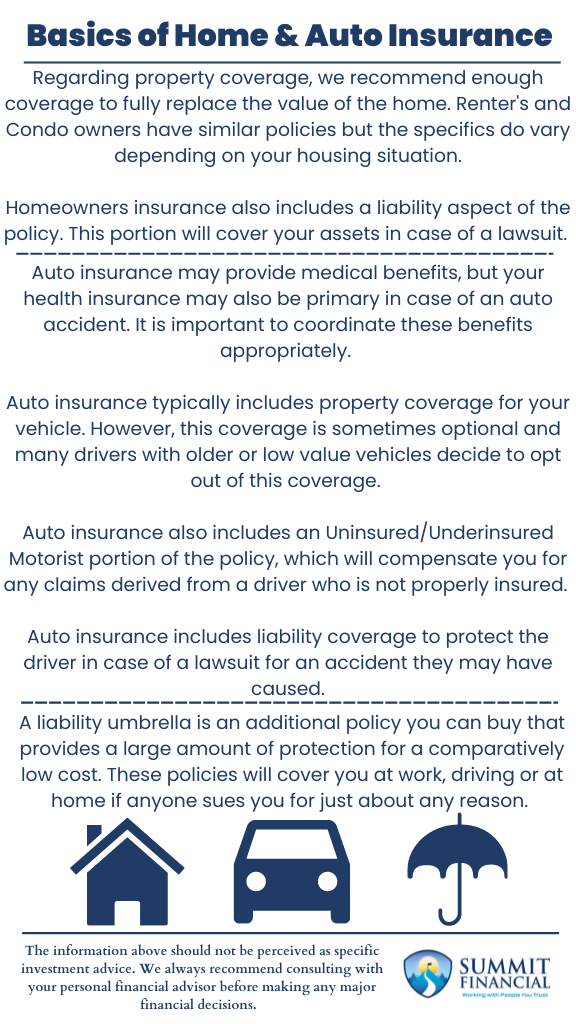Continuing our current discussion, we will be looking at various insurance types over the past couple of months. Overall, insurance is a risk management process and a critical step in mitigating risk. Risk is managed by buying the insurance policy to protect against a financial loss event. We will cover the basics of life, health, disability, and finally home and auto insurance.
This month we will be focusing on home and auto insurance, including expected policy benefits and a few additional concepts that individuals should be aware of.
Protecting Yourself With Homeowner Insurance
Every homeowner should be familiar with their homeowner’s insurance. This insurance is usually mandatory to receive a mortgage, and the mortgage provider may also implement specific coverage requirements. Renter’s insurance is sometimes an optional policy based on the apartment guidelines, but we usually recommend considering the coverage since it is usually very affordable.
Renter’s insurance typically only provides coverage for personal belongings and personal liability coverage. Condo insurance is very similar to homeowner’s insurance, except that it focuses exclusively on the inside of the property. The condo association is usually responsible for insurance of the home’s exterior and any outside property.

Finding the Right Coverage for Your Home
Regarding property coverage, we recommend enough coverage to replace the home’s value entirely. If you prefer rebuilding your home, you may want additional coverage to cover additional destruction costs. For example, if your home is destroyed 50% in a house fire and you want to rebuild the home, you will need to pay to destroy the remaining 50% to rebuild from the ground up.
Not every homeowner or insurance salesman considers this a cost when analyzing policies. Home insurance also includes a liability aspect of the policy. This portion will cover your assets in case of a lawsuit. For example, if someone falls and breaks their arm, they (or their health insurance provider) may sue you for medical claims.
Liability protection will cover the cost of any potential lawsuits up to the amount listed in the policy. We usually recommend having enough liability coverage to protect your personal assets and protect against risk.
Ways Car Insurance Will Protect You Against Risk
Like homeowner’s insurance, every licensed driver should be familiar with their auto insurance. Insurance requirements will vary from state to state, so it is essential to be familiar with your state guidelines. Auto insurance does have a medical insurance coordination aspect. Depending on your coverage, sometimes your medical will be the primary payer in case of an accident. If not, then your auto insurance would be primary, and your medical would be secondary.
Michigan drivers have also recently decided on medical payments from auto accidents. The recent auto insurance reform now allows drivers to choose a lesser amount of medical coverage than the previously required unlimited coverage. This is reducing the cost of policies for Michigan drivers. However, reducing this coverage may not be the best option for mitigating risk, and we recommend meeting with a professional regarding your situation before making any changes.
Understanding Auto Insurance Coverage
Auto insurance typically includes property coverage for your vehicle. However, this coverage is sometimes optional, and many drivers with older or low-value vehicles decide to opt out of this coverage. Auto insurance also includes an Uninsured/Underinsured Motorist portion of the policy. This coverage will compensate you for any claims derived from an uninsured or underinsured motorist.
This coverage is most commonly used during hit-and-run incidents when the driver at fault is unidentified. Lastly, Auto insurance includes liability coverage to protect the driver in case of a lawsuit. Drivers can be sued for additional compensation above medical payments and property damage.
Building a Comprehensive Risk Mitigation Strategy
A liability umbrella is an additional policy you can buy that provides a large amount of protection for a comparatively low cost. You can typically only get one if you have your auto and home insurance at the same insurance company. The most common option is for an additional $1,000,000 of liability coverage, which covers you at work, driving, or home if anyone sues you for about any reason. This type of policy may help you sleep at night because you know that if anyone sues you, the liability umbrella policy will help protect your hard-earned assets and mitigate risk.
Regarding shopping for insurance coverage and mitigating risk, we recommend working with an independent agency. As independents, these firms are given a more comprehensive range of carriers to quote and can often reduce your policy premiums. However, pricing and costs fluctuate from year-to-year and from provider to provider, so we recommend shopping out your coverage at least once a year.
Have More Questions?
If you have any questions about taxes, your individual investment portfolio, our 401(k)-recommendation service, or anything else regarding mitigating risk, please call our office at (586) 226-2100.
Please feel free to forward this commentary to a friend, family member, or co-worker. If you have had any changes to your income, job, family, health insurance, risk tolerance, or overall financial situation, please call us to discuss it. We hope you learned something today. If you have any feedback or suggestions, our team at Summit Financial would love to hear them.
Best Regards,
Zachary A. Bachner, CFP®
with contributions from Robert Wink, Kenneth Wink, and James Wink


